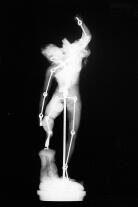Efficiency of combined MA-XRF and CXRF to give nondestructive insights about changes of a historical painting
Résumé
Historical paintings with important iconographical changes represent an analytical challenge. Considering the case study of a fifteenth-century French painting studied during its restoration, the efficiency of a combined noninvasive approach of two-dimensional scanning macro-X-ray fluorescence imaging (MA-XRF) and a laboratory-based depth-resolved confocal micro-X-ray fluorescence (CXRF) is discussed. Large chemical maps of several elements were obtained by MA-XRF, enabling the identification of zones of interest representing changes in the painting composition. In these areas, depth profiles were measured with CXRF, allowing to evidence overlaying paint layers. The advantages of this technique are that it can give direct information on the stratigraphy of paint layers in a nondestructive way and can reduce the sampling needed, as well as increase the locations analyzed (in our study twenty-two depth-resolved scans). These results complement information obtained by scanning electron microscopy coupled with an energy-dispersive X-ray analyzing system (SEM–EDX) on three cross-sectional samples taken in the areas of interest. Additionally, the three cross sections of the painting were studied by CXRF lateral scans (y) in order to evaluate the efficiency of the CXRF analyses against SEM–EDX. The study shows the benefits of the combination of MA-XRF and CXRF for analyzing painting compositions, as such a high number of cross sections would have been impossible to sample. From an art-historical and conservation perspective, this combined study provides an understanding of the original painting’s paint sequence and its later retouches, helping to make informed conservation treatment decisions. Graphic Abstract
Fichier principal
 HAL Tapia et al article 2022.pdf (1.63 Mo)
Télécharger le fichier
Tapia et al article 2022 Supplemmentary Material.pdf (2 Mo)
Télécharger le fichier
HAL Tapia et al article 2022.pdf (1.63 Mo)
Télécharger le fichier
Tapia et al article 2022 Supplemmentary Material.pdf (2 Mo)
Télécharger le fichier
| Origine | Fichiers produits par l'(les) auteur(s) |
|---|


